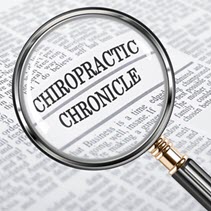Another ACA Member Added to California Board - Gives Trade Group Majority of Chiropractic Voting Block

Governor Jerry Brown’s office in Sacramento announced this week that David Paris, D.C., a 2001 graduate of Palmer College of Chiropractic has been appointed to the California Board of Chiropractic Examiners. The Board is comprised of five licensed doctors of chiropractic, plus two members who represent the public, and each serves a four-year term.
Paris is a member of the American Chiropractic Association (ACA) and joins other chiropractic members of the California Board who are also ACA Members giving the ACA affiliated Board members the majority voting block.
- HEATHER DEHN, D.C., CHAIR - ACA Member
- SERGIO AZZOLINO, D.C., SECRETARY - Northern California Delegate to the American Chiropractic Association
- DIONNE MCCLAIN, D.C. - ACA Member
- DAVID PARIS, D.C. - ACA Member
Based on his resume, Paris has been heavily involved in IME and utilization review for third party payors.
In addition to his utilization and IME work for the insurance industry and being an ACA member, Paris is also a member of the Council on Chiropractic Education Site Team Academy and the Chiropractic Clinical Guidelines and Practice Parameters Board (CCGPP). The CCGPP is known as MERCY II for those who have been in the profession for awhile. Paris served as Vice President of the California Chiropractic Association in 2015.
In addition to this history, Paris completed the Primary Spine Practitioner Certification program at the University of Pittsburgh and is board certified with the American Chiropractic Rehabilitation Board.
The notion of a chiropractor as a Primary Spine Care Physician gained notoriety in 2005 when a journal controlled by Subluxation Deniers published the paper:
Chiropractic as spine care: a model for the profession. The paper was authored by Craig F Nelson, Dana J Lawrence, John J Triano, Gert Bronfort, Stephen M Perle, R Douglas Metz, Kurt Hegetschweiler and Thomas LaBrot.
Several of those involved in the paper were affiliated with American Specialty Health (ASH). In a nutshell the paper attacked Palmer's Postulates, the management of vertebral subluxation and the philosophical underpinnings of the profession.
The addition of Paris to the California Board and the potential majority votes now represented by the ACA members mirror what is happening on several state chiropractic regulatory boards and the Boards of several chiropractic colleges where ACA members dominate the voting block.
Beyond the longstanding history of the ACA, the immediate concern to chiropractors managing vertebral subluxation in a salutogenic model is that the American Chiropractic Association has recently rebranded itself and adopted standards of care that are inconsistent with the management of vertebral subluxation and present a threat to public health.
The ACA requires its members to sign a pledge agreeing to the standards of practice promulgated by the organization.
The ACA standards include a list of five tests it states are commonly ordered but not always necessary in chiropractic care. The recommendation includes the admonition to not take spinal x-rays in acute low back pain patients unless there are so called "Red Flags" and to never take repeat x-rays to monitor progress. Teaming up with ABIM Foundation and Consumer Reports, the ACA’s President referred to these as “unneeded or overused services” and that following these recommendations would yield the “best possible care”.
The recommendations by the ACA, which has been pushing hard to remove subluxation language from Medicare and to expand the scope of practice of chiropractic nationwide including drugs, are at odds with what is considered to be a standard of care within chiropractic.
Despite this, insurance companies have already adopted the guidelines and are making payment and clinical necessity decisions based on them.
A number of chiropractic techniques rely on x-rays in order to determine the misalignment (biomechanical) component of the vertebral subluxation and imaging (especially plain film) is the only objective, valid and reliable method to make that determination.
Further, those techniques require the taking of follow-up x-rays in order to determine whether or not the misalignment has been reduced or corrected.
Insurance companies have for decades attempted to deny reimbursement for radiographs taken for this purpose. Subluxation deniers, and some trade organizations like the medically oriented ACA, have sought to paint such practices as unprofessional and to steer consumers away from chiropractors who rely on these procedures in order to administer care.
The ACA’s recommendations regarding x-rays are at odds with several other recommendations by chiropractic trade organizations, best practices, and standard of care guidelines as well as what is taught at several chiropractic schools in the United States.
Palmer Chiropractic College issued a Press Release lauding Paris with a Headline:
Palmer Alumni-Leadership: Advancing the Profession.
Paris stated “I feel extremely grateful, humbled and honored to be appointed by Governor Brown.”
CLICK HERE for more about Palmer and the ACA

Blogs
- The Chiropractic Cartel: A Look Back at Bias in Accreditation and its Imact on Today's Profession
- Inside Montana's Chiropractic Monopoly: ACA & MCA's Brazen Board Takeover
- Concerns Grow About Control of the NY State Chiropractic Board by the ACA - Use of X-ray in NY Under Threat
- Reproductive Health Information and Chiropractic Care: Navigating New Privacy Regulations
- Navigating Substance Use Disorder (SUD) Consent: What Chiropractors Need to Know













